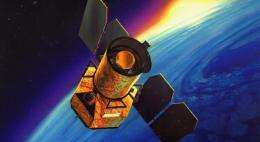Space Telescope Moves on with One Detector

(PhysOrg.com) -- Mission engineers and scientists with NASA's Galaxy Evolution Explorer, a space telescope that has been beaming back pictures of galaxies for three times its design lifespan, are no longer planning science observations around one of its two ultraviolet detectors.
"The remaining, near-ultraviolet detector is still busy probing galaxies both nearby and distant," said Kerry Erickson, the mission's project manager at NASA's Jet Propulsion Laboratory in Pasadena. "We've got lots of science data coming down from space."
The Galaxy Evolution Explorer rocketed into space from a jet aircraft in 2003. For four years of its primary mission, it mapped tens of millions of galaxies across the sky in ultraviolet light, some as far back as 10 billion years in cosmic time. Its extended mission began in 2008, allowing it to probe deeper into more parts of the sky, and pluck out more galaxies.
Last May, the spacecraft's far-ultraviolet detector experienced an over-current condition, or essentially "shorted out," via a process called electron field emission. This detector sees higher-energy ultraviolet light, and thus hotter and younger stars within galaxies, than the telescope's other, near-ultraviolet detector. (The far-ultraviolet detector sees light with wavelengths between 135 and 180 nanometers, while the near-ultraviolet detector sees wavelengths between 180 and 280 nanometers.)
The far-ultraviolet detector has contributed significantly to the Galaxy Evolution Explorer's quest to understand how galaxies, including those like our own spiral Milky Way galaxy, blossom into maturity. It specializes in studies of star formation in nearby and distant galaxies. Perhaps the most significant discovery in this area is the identification of a transitional phase of galaxies, the teenagers of the galactic world. Astronomers long knew of young galaxies churning out stars, in addition to older, or dead, galaxies. But they did not know for certain whether the young ones mature into the older ones until the Galaxy Evolution Explorer found the missing links - the transitional galaxies (see www.physorg.com/news114365801.html).
In addition, one of the far-ultraviolet detector's most stunning finds is the humungous comet-like tail behind a speeding star called Mira. (See www.physorg.com/news106404409.html).
While the discovery of Mira's tail required the now-offline detector, almost all of the mission's targets could be seen by both detectors. Astronomers used the detectors' observations at different wavelengths to get an idea of a star or galaxy's temperature, age and mass. Much of this research can now be done by comparing near-ultraviolet data from the Galaxy Evolution Explorer with catalogued visible-light data from other telescopes. In addition, the wealth of far-ultraviolet observations to date will continue to be mined for decades to come.
Provided by JPL/NASA


















